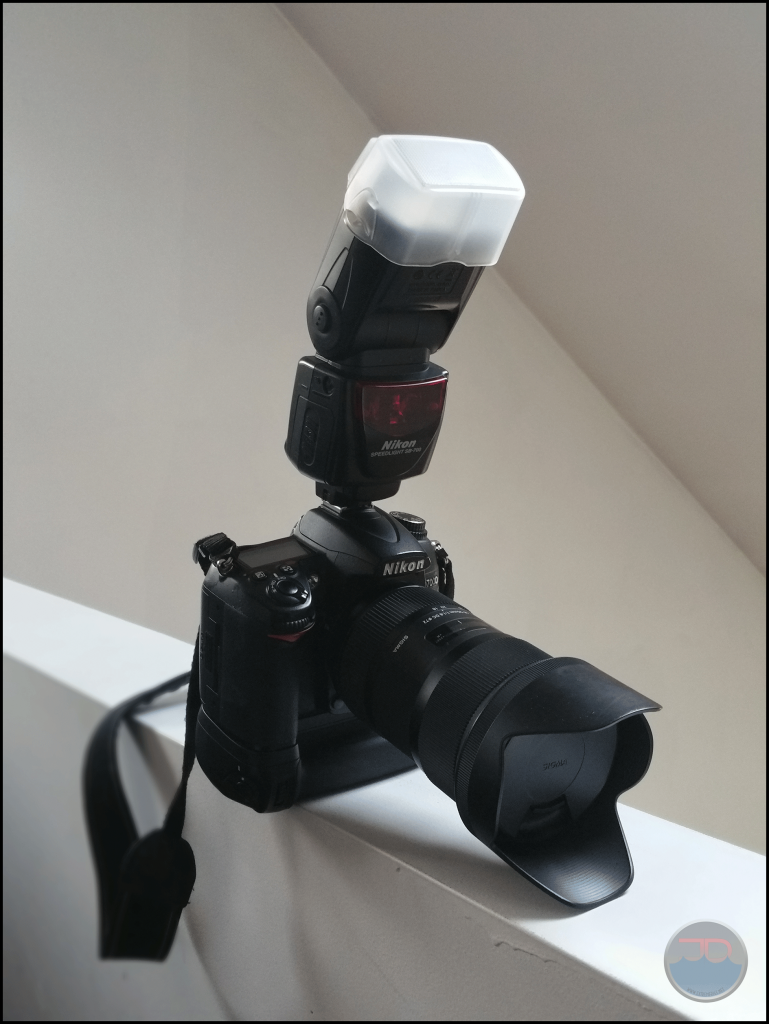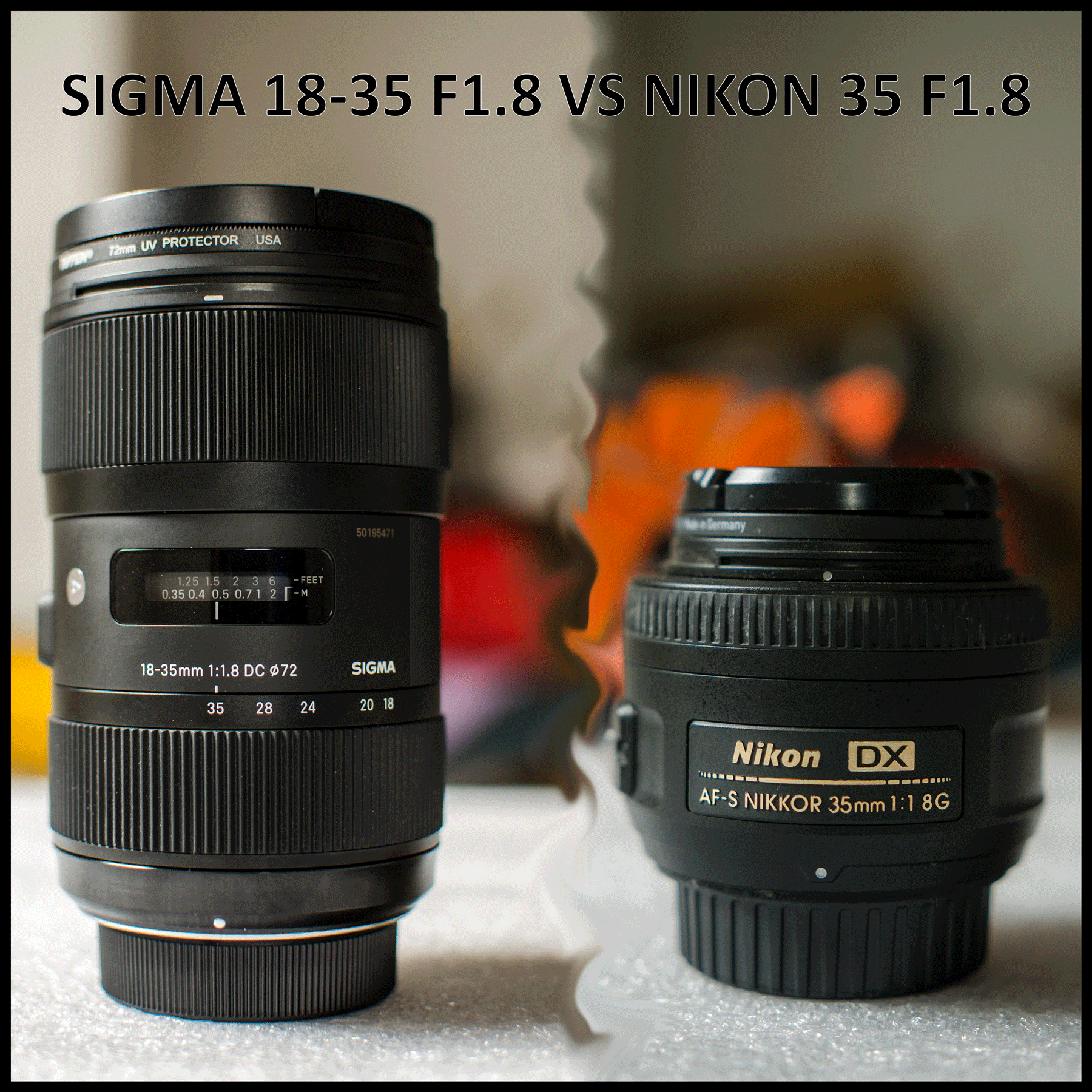Ergonomics
The Sigma 18-35mm is a huge lens. In order to achieve the amazing constant F1.8 aperture at all focal lengths, a lot of glass had to be used. Weighing in at over 800g, the Sigma 18-35mm is no less than four times the weight of the Nikon 35mm! Ergonomics is where prime lenses shine, and we expect this. If Sigma had managed to achieve a constant maximum aperture of F1.8 on any size zoom lens and kept the weight comparable to that of a prime’s, you wouldn’t need anything else! Despite this being expected, it may be a deal breaker for some. While a DX camera body by itself doesn’t weigh much, 690g on the Nikon D7000 we used in this review, once you start adding on a grip/additional battery pack, an external flash, and a lens that weighs more than the body itself, you’re quickly approaching 6lbs!

The most important question is, “how does it feel in your hands?” There are two types of photographers; the ones that like to have a bit of bulk in their hands and have no problem shooting with it and the type that prefers to have a lightweight kit because they’re shooting all day long and 2lbs compared to nearly 6lbs, is a huge difference! We at ExtremeRigs are mostly part of the former, however even we noticed how big the Sigma really is. Not only does it weigh four times as much as the Nikon, but it’s also more than twice as long! We love both of these lenses but if you’re shooting all day, especially if you’re using a grip and an external flash (which frankly you should be if you’re doing this professionally) then we’d prefer the Nikon. We don’t blame the Sigma considering its impressive aperture and focal length but we have to be realistic and look at this lens from both an amateur and professional angle. In the end, ergonomics are all about what matters to you. Some may view the Sigma 18-35 as more ergonomical due to simply being a zoom lens and being able to use it in a larger amount of situations. While others may view the Nikon 35mm more ergonomical simply due to its size and weight.
Focus & Zoom Rings
Another important aspect that needs to be pointed out are the rings of each respective lens. The Nikon features the same style of ring that is used on all modern Nikon lenses. It’s quick, smooth and gets slightly stiffer when you go past infinity or its minimum focus distance. The grip on the ring itself is comfortable, however due to having no display of the current focus distance, it can be hard to determine where infinity is exactly. The grip of the zoom and focus rings on the Sigma 18-35 are very different, but not necessary in a good or bad way. The rings themselves aren’t as easy to adjust as the Nikon’s are, but they make up for that with accuracy. The rings are buttery smooth and provide much more accuracy than the Nikon’s. On top of this, the Sigma also offers an analogy display on the lens that tells you what your current focus distance is. Although many don’t view these displays as necessary, I find them very important for manual focusing. Especially in very low light situations, such as shooting the night sky where you know you’ll need to set your camera to infinity manually. Like with ergonomics, neither the Nikon or Sigma solution is particularly bad, but it is up to personal preferences.
No matter which way you judge which lens has better ergonomics, you need to know what your tripod can handle! For our test samples we used a MeFOTO 2-Series Travel Tripod with our testing and didn’t experience any issues with tipping or balance. However, for the sake of testing, we attempted to use a JOBY Gorilla DSLR tripod and found that it was just a little bit too heavy for this small, low weight tripod. If positioned correctly you may use a tripod like the JOBY but be warned that you may be quite limited with how you position the tripod.
Distortion
A lot of people who are new to photography may not realize that no lens is perfect. In fact, it’s very rare for a lens to be distortion free! What is distortion exactly you may ask?

The most common form of photography lens distortion that we’re familiar with, but may not even realize is due to distortion, are fisheye lenses. It’s no coincidence that fisheye lenses are only extremely wide! While fun, I imagine most people wouldn’t want to use a fisheye as their everyday lens due to the large amount of distortion. Programs like Adobe Photoshop can correct for distortion found in most modern lenses, however when using a Fisheye, the corrections aren’t always perfect and you can experience even weirder distortion in your final photos.
Despite lens distortion being more traditionally common on zoom lenses, as you can see in the two photos the distortion is surprisingly a lot less obvious in the Sigma 18-35mm than it is in the Nikon 35mm. While this is good news it is worth noting that due to the Sigma lens being quite a bit newer, Photoshop currently does not have a lens correction profile for it, while it does for the Nikon.
Focus Breathing
Focus breathing is most likely a “feature” that everyone has experienced but has no idea that they’re experiencing it. “‘Focus breathing’ is the name often given to the change of focal length (and hence angle of view and magnification) when the focus distance of a lens is changed.” As you’re reading through this review you may notice that the direct comparison photos aren’t exactly the same. In fact all of the objects in the Sigma photos appear to be closer or are zoomed in further. We assure you, all of the photos were shot at the focal length specified and all of the objects were consistently in the exact same position that they were in for the Nikon. This “extra zoom” is Focus Breathing. Lens manufacturers don’t like to talk about it and often neither do lens reviewers because it’s unfortunately an anomaly that introduces inconsistencies, inconsistencies that can’t be predicted or generalized. Due to the nature of this review, comparing two lenses head to head, we feel that it is important to highlight Focus Breathing in order for our readers to understand completely what is going on. You can read more about focus breathing here.
Focusing & Accuracy
A big reason why a lot of photographers prefer to shoot “first party” lenses made by the same manufacturer who made their camera body is the autofocus ability can sometimes be inaccurate or inferior in general. While this may be true in the past, Sigma has stepped up their game and the 18-35 performs absolutely wonderfully. I don’t think I need to explain why it’s important for your auto focus to be as accurate as possible is so terribly important. The importance of your autofocus at any event, from a simple wedding to the olympics, is absolutely crucial. On a small camera body LCD you aren’t able to tell if you got the accuracy 100% where you wanted it, even if it did, you don’t have time to check that after every photo you take.
That being said, both the Nikon and SIgma lens have their pros and cons. In order to test focusing we put both lenses through three situations that most photographers will find themselves in at some point. The first being normal, everyday shooting inside and outside. The second was higher speed situations that involved our subjects in motion as well as tests while we were in motion while taking photographs. The last was live view focusing while shooting photos of our main rig.
Throughout our testing we noticed that the Nikon lens focused quicker and often more accurately than the Sigma when shooting through the viewfinder; particularly when our subjects or we were in motion. However, while they both focused with the same accuracy in live view mode, the Sigma found its focus point quicker and locked in continuously faster than the Nikon. As with ergonomics, it depends what you use your lens for more commonly. If you shoot through the viewfinder, the Nikon is superior, while if you shoot through live view mode, the Sigma will be the better choice.
As most photographs shoot through the viewfinder and due to the inaccuracies by the Sigma, we’re going to give this category to Nikon. The Sigma 18-35 is compatible with the company’s specialized USB dock that allows for fine tuning of the AF system.











Buenas tardes,
Me parece interesante su articulo porque estoy en el dilema de ver que lente comprar pero las fotografias comparativas no se cargan y no puedo ver diferencias entre uno u otro lente que me den idea que tal se ve uno u otro.
Podrian por favor subir nuevamente las fotografias para poder ver las comparativas.
Gracias de antemano.
Saludos.
Hello great review there but page 4-8, the images are unable to load. Issit only me?
Hi,
great article! But please check why some photos are not appearing. Unfortunately I cannot see some of them.
Thanks!
Comments are closed.